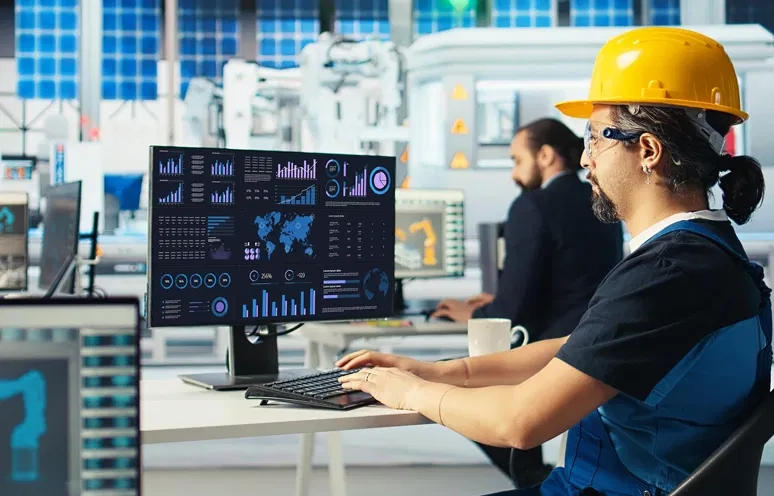In today’s complex business world, the key to minimizing mistakes in decision-making lies in relying on data insights. Effectively tapping into the potential of data can open up new possibilities. Microsoft Fabric can play an essential role here by serving as a consolidated data and analytics platform. The tool streamlines data integration, management and analysis for businesses. Essentially, it combines different tools and services from Microsoft Azure into one cohesive platform, offering an all-in-one solution.
MS Fabric combines all the good stuff together:
Brains of AI: Automate tasks, predict issues and make your processes smarter.
Supercharged insights: BI unveils hidden patterns in your data, like a treasure map to success.
Process twins: Imagine exact copies of your operations, able to learn and adapt with you.

Elements of Microsoft Fabric
Microsoft Fabric umbrella has these 3 products:
1. Data factory
Provides more than 150 connectors to cloud and on-premises data sources, drag-and-drop experiences for data transformation and the ability to orchestrate data pipelines.
2. Power BI
Provides industry-leading visualization and AI-driven analytics that enable business analysts and business users to gain insights.
3. Data Synapse
- Data engineering experience provides a world-class platform with great authoring experiences, enabling data engineers to perform large-scale data transformation and democratize data through lake houses.
- Data science provides an end-to-end workflow for data scientists to build sophisticated AI models, collaborate easily, and train, deploy and manage machine learning models.
- Data warehouse provides a converged Lakeview House and data warehouse experience with industry-leading SQL performance in an open data format.
- Real time analytics enables developers to work with data streaming in the form of Internet of Things (IoT) telemetry logs and more. It analyzes a massive volume of semi-structured data with high performance and real-time data processing for prediction resulting in low latency.
4. Data activator (preview)- provides real-time detection and monitoring of the data. It can trigger a notification for actions when it finds a specific pattern in the data.
OneLake
To understand OneLake, think of the M365 application as interconnected with OneDrive. It’s like OneDrive for data, where various workloads are neatly organized in an intuitive data hub. This system automatically indexes sites for tasks like discovery, sharing, governance, and compliance. So essentially, it’s like having one drive for all your data needs.
Microsoft Fabric: Powered by AI
Microsoft Fabric brings Copilot into every aspect of your data experiences, making tasks from integrating data to writing code and uncovering insights more intuitive. With Copilot integrated, you can ask questions in natural language, allowing transformative AI experiences to assist you at every step.
Copilot helps you build machine learning models by turning your words into data flows or data pipelines. Just by chatting with Copilot, you can visually explore your data and create reports with easy-to-understand text narratives.
Beyond that, Copilot enables you to convert insights into actions through triggers that monitor and notify users about changes in your data. We can even create custom natural language experiences by combining Azure open AI models with your organization’s data, effortlessly publishing your creations as plugins.
The user-friendly interface and AI-powered capabilities of Fabric and Copilot streamline data analysis, enabling users to quickly translate insights into actionable outcomes.
Decide better with Microsoft Fabric
Let’s understand how Microsoft Fabric can be helpful in making important business decisions.
For example, you are a marketing director for a shoe company, and you’re trying to decide whether to launch a new line of running shoes. Traditionally, these decisions were taken based on gut feelings, past sales figures or competitor analysis.
However, with Microsoft Fabric, you can make a data-driven decision that considers a wider range of factors and gives you a much clearer picture of your potential success.
Here’s how some Fabric features can help:
1. Unified data from multiple sources:
Let’s assume you have data available on website traffic, customer demographics, social media engagement and in-store purchases. Fabric can unify all this data from different sources, like on-premises databases, cloud storage and social media platforms, into one place. This gives you a complete view of your audience and your brand’s current standing.
2. Analyze data with powerful tools:
With Fabric, you don’t need to be a data scientist to make sense of your numbers. Tools like Power BI let you create interactive dashboards and visualizations that show trends, patterns and correlations in your data. You can see, for example, which demographics are most interested in running shoes and what types of content they engage with.
Interesting features of Power BI that can help you gain more insights into your data are:
- Anomaly detection – Identify unexpected patterns and outliers.
- Key influencer analysis – Discover key drivers behind trends and patterns in your data.
- Automatic clustering – Similar data points are clustered into color-coded groups.
- Smart Narratives – Explaining the key findings and trends.
3. Use AI for predictive analytics with Microsoft Fabric:
Fabric’s AI capabilities, like Azure Machine Learning, can help you take your analysis further. By feeding your data into machine learning models, you can predict things like future sales volume, customer churn, and even the most effective marketing channels for your new shoe line.
4. Collaborate and share insights:
Fabric isn’t just for data analysts. It’s designed for collaboration. You can easily share your dashboards and reports with other stakeholders in your company, like the CEO, sales team, and product developers. This allows everyone to be on the same page and make informed decisions based on the data.
5. Take action based on insights:
Ultimately, data is useless unless you act on it. MS Fabric’s triggers and automation features let you set up alerts based on specific data points. For example, you could be notified if there’s a sudden surge in interest in running shoes in a particular region, prompting you to launch a targeted marketing campaign there.
Decoding decisions with Microsoft Fabric
Microsoft Fabric delivers a comprehensive and integrated solution, seamlessly blending data, analytics, and AI to empower data-driven decision making.
Remember, data-driven decision making isn’t just about numbers; it’s about using those numbers to understand your customers, market trends, and ultimately, make smarter business choices. Contact us to leverage Microsoft Fabric to gain the insights you need and turn your data into meaningful action.



